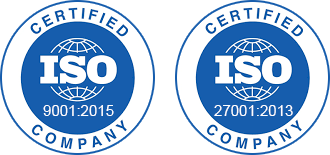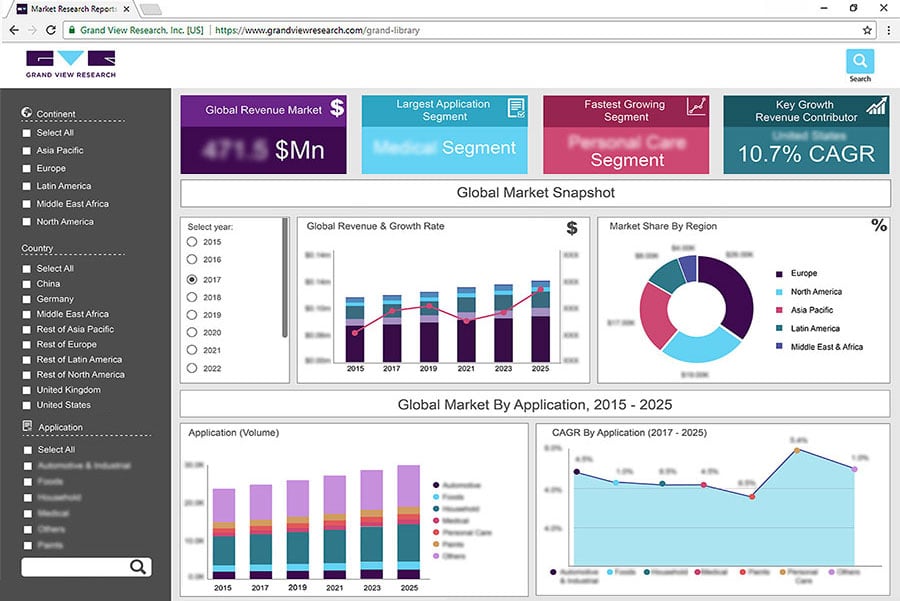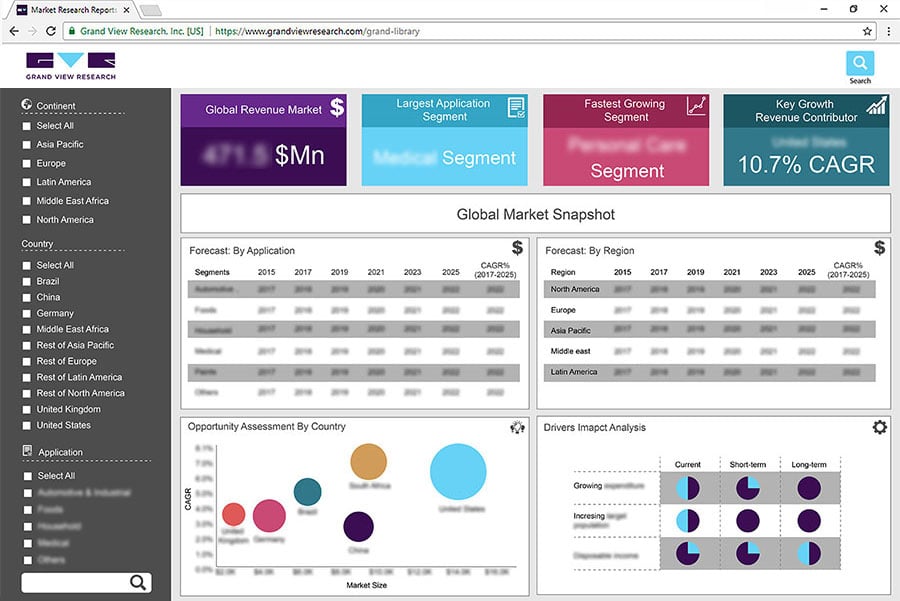- Home
- »
- Biotechnology
- »
-
Global Agricultural Biotechnology Market Size, Industry Report, 2025GVR Report cover
![Agricultural Biotechnology Market Size, Share & Trends Report]()
Agricultural Biotechnology Market Size, Share & Trends Analysis Report By Application (Vaccine, Flower Culturing, Biofuels), Organism (Plants, Animals, Microbes), By Region And Segment Forecasts, 2019 - 2025
- Report ID: GVR-3-68038-839-8
- Number of Report Pages: 149
- Format: PDF, Horizon Databook
- Historical Range: 2014 - 2018
- Forecast Period: 2019 - 2025
- Industry: Healthcare
Industry Insights
The global agricultural biotechnology market size was estimated at USD 89.89 billion in 2018 and is projected to grow at a CAGR of 7.07% during the forecast period. An increase in demand for new breeding techniques is expected to propel the market growth. This is supplemented by increasing penetration of biotechnology tools to create or modify traits of organisms-including plants, animals, and microbes-with respect to color, yield, or size.
Biotechnology tools are gaining significant demand across agricultural applications. These include tissue culture and micropropagation, marker-assisted selection or molecular breeding, genetically modified crops & genetic engineering, molecular diagnostic technologies, and conventional plant breeding.
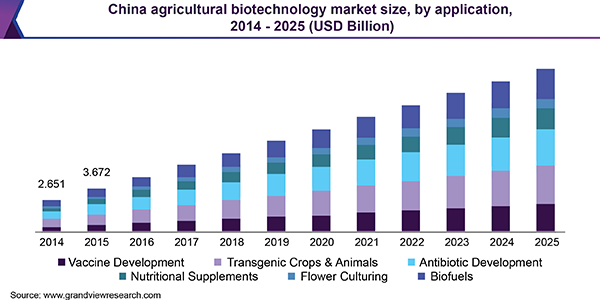
A rise in the adoption of Genetically Modified (GM) crops globally is expected to drive the market throughout the forecast period. This is because genetic modification allows the production of feed and food crops with enhanced characteristics such as high nutritional value, high yield, enhanced food-processing qualities, and resistance against diseases and insects. In many countries, GM crops have been adopted rapidly, and the market for insect-resistant, herbicide-tolerant GM seeds is among the growing sectors of the agricultural industry.
According to the estimates of International Service for the Acquisition of Agri-biotech Applications (ISAAA), 2.15 billion hectares of biotechnology crops have been commercially grown from 1996 to 2016. This includes 0.34 billion hectares of biotechnology cotton, 1.04 billion hectares of biotechnology soybean, 0.13 billion hectares of biotechnology canola, and 0.64 billion hectares of biotechnology maize. These products contribute to a major portion of fiber, feed, fuel, and food consumption globally.
Application Insights
The agricultural biotechnology market is classified into six segments based on application, namely vaccine development, transgenic crops & animals, antibiotic development, nutritional supplements, flower culturing, and biofuels. Transgenic crops & animals segment generated the highest revenue in 2018 while vaccine development is estimated to witness the fastest growth than other applications.
Agricultural biotechnology has helped in livestock as well as crop enhancement via incorporating advanced tools. Agriculture-integrated biotechnology finds vast applications across tissue culture, micropropagation, embryo transfer, cloning, and artificial insemination among others. Biotechnology tools have been applied successfully in micropropagation of disease-free plants, improving aluminum tolerance, crop fortification, and genetic modification in crops.
Organism Type Insights
Agricultural biotechnology involves the use of a broad range of modern techniques to develop innovative products with enhanced quality traits. Conventional breeding techniques have been adopted largely to carry out alterations in plant and animal genomes. In addition, advancements in the field of genetic engineering have enabled controlling of genetic changes induced into the organism.
Advanced biotechnology tools have enabled professionals to incorporate new genes from one species to another unrelated species targeting towards the optimization of agricultural production or manufacturing valuable pharmaceutical compounds. The most common subjects of genetic engineering include farm animals, crops, and soil bacteria.
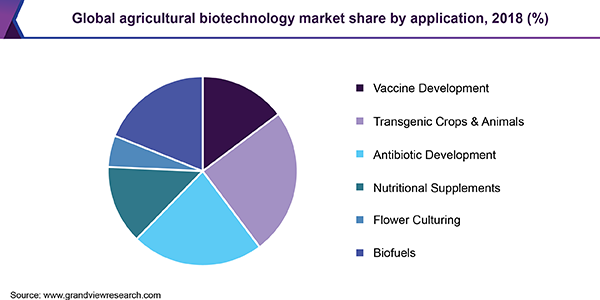
The global agricultural biotechnology market is classified into three segments based on the organism: plants, animals, and microbes. The plants’ segment has generated the largest revenue in 2018 and is expected to maintain its dominance throughout the forecast period. Whereas the animals’ segment is expected to grow at the fastest CAGR in the coming years. Each of the segments of organism outlook is further classified into three segments based on techniques; conventional techniques established genetic modification and new breeding techniques.
Regional Insights
North America dominated with the largest revenue share in 2018, owing to its wide range of agro-climatic zones and crops, along with a large global Genetically Modified (GM) planted area. In this region, the U.S. and Canada together represent around 50% of the global GM area and around 10% global planted area. Major crops cultivated in around 70% of the cultivated area of North America include corn, soybean, and wheat, followed by alfalfa, cotton, canola, & barley. Moreover, North America is a net exporter of agricultural products with around 30% production of corn, soybean, and wheat globally.
Whereas, Asia Pacific is expected to grow at the fastest pace during the forecast period. This region is characterized by the presence of several with different political & economic systems, cultural backgrounds, and languages. Within these, the agricultural industry varies from the adoption of high technical standards in Japan to basic systems in India.
Asia Pacific serves as a lucrative market as the region occupies nearly 40% of the global cropped area (nearly 600 million hectares). The region is also characterized by the importance of rice crop (except Australasia), and the predominance of smallholders. Rice is available at highly subsidized rates across Asia and food security is a major concern for local governments in most of its developing economies. The region holds nearly 90% of the total crop area for rice, with 20% and 28% in China and India respectively.
Agricultural Biotechnology Market Insights
Key players in the market include KWS SAAT SE & Co. KGaA, ChemChina, Limagrain, Nufarm, Marrone Bio Innovations, Performance Plants Inc., Corteva, ADAMA Ltd, MITSUI & CO., LTD, Evogene Ltd., Valent BioSciences LLC, and Bayer AG. These companies are adopting several strategies to maintain their market presence.
Over the years, the market has witnessed a substantial number of product launches. For instance, in July 2019, KWS SAAT SE & Co. KGaA launched six new hybrid corn varieties as part of its brands, KWS and Riber, in Brazil. These varieties provide high genetic protection against insects, high yield, and tolerance against herbicides. This launch allowed the company to provide an innovative portfolio of seeds to Brazilian farmers, thereby improving their presence in Brazil.
Report Scope
Attribute
Details
Base year for estimation
2018
Actual estimates/Historical data
2014 - 2018
Forecast period
2019 - 2025
Market representation
Revenue in USD Billion and CAGR from 2019 to 2025
Regional scope
North America, Europe, Asia Pacific, Latin America, and Middle East & Africa
Country scope
U.S., Canada, Germany, U.K., Japan, China, Brazil, and South Africa
Report coverage
Revenue forecast, company share, competitive landscape, growth factors and trends
15% free customization scope (equivalent to 5 analyst working days)
If you need specific information, which is not currently within the scope of the report, we will provide it to you as a part of customization
Segments Covered in the ReportThis report forecasts revenue growth at global, regional, and country levels and provides an analysis of the latest industry trends in each of the sub-segments from 2014 to 2025. For the purpose of this study, Grand View Research has segmented the global agricultural biotechnology market report on the basis of application, organism type, and region:
-
Application Outlook (Revenue, USD Billion, 2014 - 2025)
-
Vaccine Development
-
Transgenic Crops & Animals
-
Antibiotic Development
-
Nutritional Supplements
-
Flower Culturing
-
Biofuels
-
-
Organism Type Outlook (Revenue, USD Billion, 2014 - 2025)
-
Plants
-
Conventional Techniques
-
Established Genetic Modification
-
New Breeding Techniques
-
-
Animals
-
Conventional Techniques
-
Established Genetic Modification
-
New Breeding Techniques
-
-
Microbes
-
Conventional Techniques
-
Established Genetic Modification
-
New Breeding Techniques
-
-
-
Regional Outlook (Revenue, USD Billion, 2014 - 2025)
-
North America
-
The U.S.
-
Canada
-
-
Europe
-
Germany
-
UK
-
-
Asia Pacific
-
China
-
Japan
-
-
Latin America
-
Brazil
-
-
Middle East & Africa
-
South Africa
-
-
Share this report with your colleague or friend.
![gvr icn]()
NEED A CUSTOM REPORT?
We can customize every report - free of charge - including purchasing stand-alone sections or country-level reports, as well as offer affordable discounts for start-ups & universities. Contact us now
![Certified Icon]()
We are GDPR and CCPA compliant! Your transaction & personal information is safe and secure. For more details, please read our privacy policy.
We are committed towards customer satisfaction, and quality service.
"The quality of research they have done for us has been excellent."
